Part 30: Episode 30: The Simplest Truth
This update covers:Gabriel Cunningham 5 - The Simplest Truth (Part 2 of 2)

When we last left off, Gabe's son had just suddenly started bleeding internally. Something's going on here.
Gabe: Hm... hemorhaging spots on the left side of the abdomen and near the navel. RONI, write those down.
RONI: New symptoms: "Blood Spots on Left of Abdomen" and "Blood Spots near Navel."
Now that Joshua is cooperating, we'd better ask him about his symptoms.
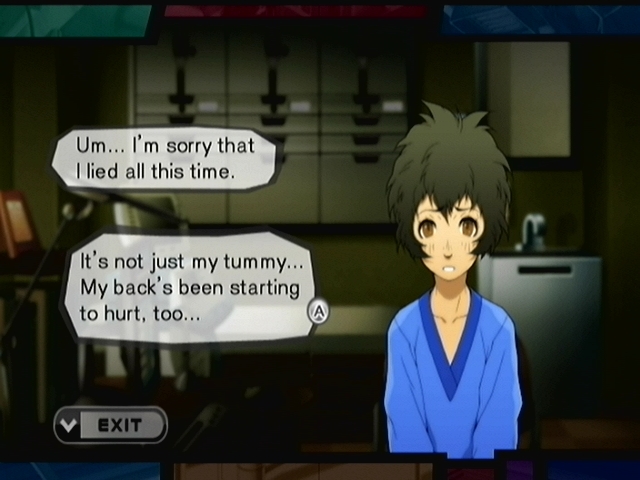
Joshua: It doesn't hurt so much that I can't bear it, but it hurts a lot. Also... I don't feel well. I feel like I'm going to throw up any minute. Uh, if there's anything more, I'll tell you right away, Doctor.
Okay, he's being straightforward with us, finally. Back pain and nausea can be added to the list.
Gabe: His condition must be getting worse. RONI, this is important.
RONI: New symptoms: "Back Pain" and "Nausea."
Now we finally have enough info to go on, so we can scoot on back to the office. Might also want to fetch a bucket or something for if the kid gets sick.
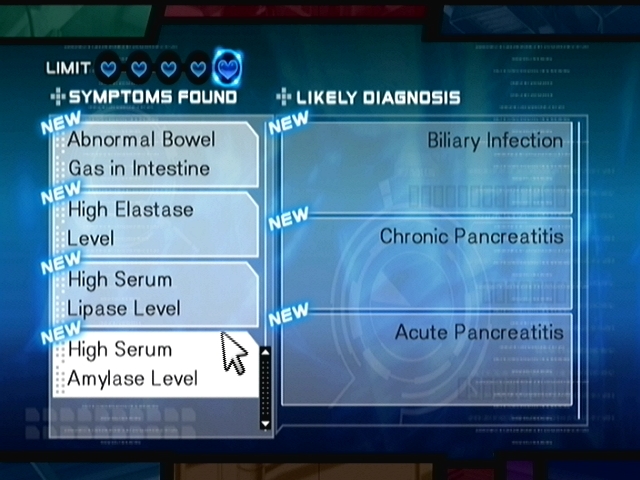
Symptom List:
Blood Spots Near Navel
Blood Spots Near Abdomen
Nausea
Back Pain
Swollen Pancreas
Abnormal Bowel Gas in Intestine
High Elastase Level
High Serum Lipase Level
High Serum Amylase Level
Biliary Infection:
A condition that causes various symptoms due to a stone forming in the biliary tract. This is caused by symptoms such as extreme stomachaches, fever, nausea, lack of appetite, and abdominal bloating. Jaundice and shaking [snip]
Yeah, this one isn't working out.
Chronic Pancreatitis:
A condition in which the pancreas becomes continuously inflamed for long periods of time, causing detrimental affects to the pancreas and its abilities. Symptoms include back pain and nausea. A blood analysis will detect abnormalities such as high serum amylase, high serum lipase, and high elastase levels. An X-Ray exam will reveal calcification within the pancreas. [snip]
This is close to what we're seeing, but no calcification. The symptoms don't really indicate this as a chronic condition anyway. The next, one, however...
Acute Pancreatitis:
A condition in which the pancreas becomes digested due to activation of pancreatic enzymes. Symptoms such as back pain and nausea appear, and it's possible for blood spots to appear on the left side of the abdomen and near the navel due to subcutaneous hemorhaging. An analysis exam will show [etc etc]. An X-ray exam will reveal abnormal intestinal bowel gas. A CT exam will show a swollen pancreas due to inflammation.
Bingo.
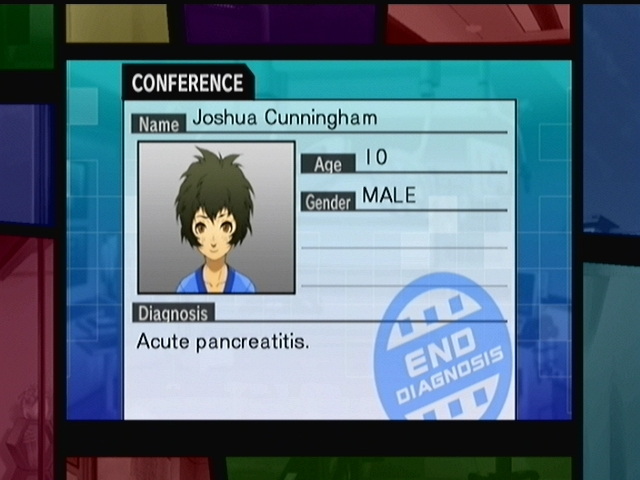
Gabe: I find it hard to believe that this could have caused the relapse of his gastric ulcers. Dammit... there's still something else! RONI, I'm continuing with the diagnosis. We're not done yet.
RONI: I'll follow your lead, Doctor.

RONI: It is plausible that the chief illness caused it, like the ulcers.
Gabe: What in the heck is going on!?
RONI: We can only hope our examination will answer that, Doctor.
Gabe: *sigh* Yeah... I hate dealing with all these complications.

Gabe: It's going to take a little longer. Is your body alright?
Joshua: It still hurts a little, but you're going to fix me soon, right?
Gabe: That's right. Hang in there, but if it gets too much to handle you tell us right away, okay?
Joshua: Okay, I promise.
Well, we can question him again, and given the rate at which his condition has been going crazy I think it's a good idea.
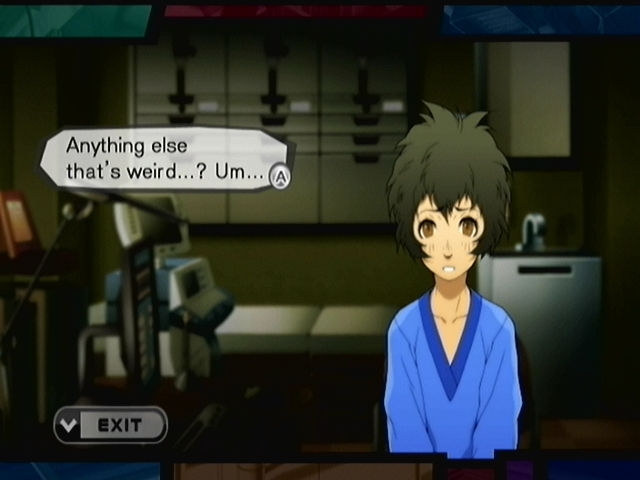
Joshua: ...Huh? I'm not hiding anything anymore! Um, I've started getting real thirsty. I've been going to the bathroom a lot, too. That's it. Is it important? It's, heheh, kinda embarrassing.
Gabe: I see. This is polydipsia and poluria. RONI, make a note.
RONI: New symptom: "Polydipsia and Poluria."
In addition, we can take another look at the magic number exam. Might as well get that over with.
Serum Calcium: A mineral forming bones and teeth. Calcium in blood plays a role in finding abnormalities in hormones, intestines, bones and kidneys. Normal level 8.5 ~ 10.2. Measured level 12.7
Gabe: His blood calcium is way past the average levels. Got that one?
RONI: New symptom: "High Blood Calcium Level."
Serum Phosphorus: A substance in bones and teeth with important functions in all cell types. Can reflect hormonal abnormalities. Normal Level 2.5 ~ 4.5. Measured level 1.5
Gabe: That's abnormally low. Another piece of the puzzle.
RONI: New symptom: "Low Serum Phosphorus Level."
Serum PRL: A hormone produced in the pituitary gland that influences various reproductive glands. May also indicate pituitary gland disorders. Normal level 3.6 ~ 12.8. Measured level 14.2.
Gabe: Yep. High blood PRL level. RONI, mark it down.
RONI: New symptom: "High PRL Blood Level."
Serum Gastrin: A hormone secreted by the stomach's pyloric antrum. Used in examining gastric disorders in the pancreas, duodenum, and bile duct. Normal level 40 ~ 140. Measured level 439.0
Gabe: Record that.
RONI: New symptom: "High Serum Gastrin Level."
Intact-PTH: Intact Parathyroid Hormone is a type of hormone secreted by the parathyroid gland used to stabilize calcium levels. Normal level 10 ~ 60. Measured level 328.0
Gabe: It's showing some very high levels. Put it on his chart, RONI.
RONI: New symptom: "High Intact-PTH Level."
Gabe: What the heck... so many abnormal levels suddenly appeared.
RONI: The cause is unknown, but the analysis is at least 97% reliable.
Gabe: That's why I'm worried. Let's go back to the office.
All of these latest symptoms have been for substances related to hormones, but they've been coming from all over the body. It's obvious that this one is pretty crazy.
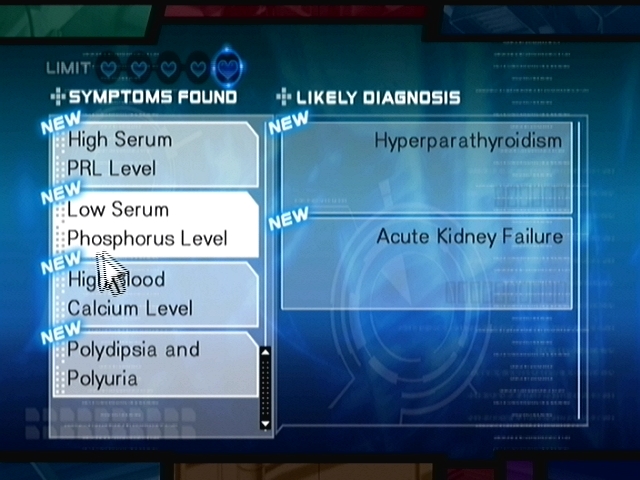
Since the list is so short this time, let me just give you the disease candidate.
Hyperparathyroidism:
A condition that causes various symptoms due to increased production of parathyroid gland hormones. Polydipsia and poluria will be evident, and an analysis exam will show abnormalities such as high blood calcium level, low serum phosphorus level, and high intact-PTH level. An X-ray examination will confirm the presence of subperiosteal bone resorption on the thumbward sides of the index and middle fingers, and an abnormal accumulation into the parathyroid adenoma will be confirmed through scintigraphy.
We have a bunch of symptoms besides the ones listed, but there's nothing to rule this out as occuring, either...
Gabe: There are a number of symptoms which don't apply, but this seems to be the closest match.
RONI: X-ray and scintigraphy exams will be necessary to make a definitive diagnosis.
There are going to be a LOT of images in this section, I will warn you now.
X-RAY_01
Patient:

Sample:

This one's hard to see, but just compare the two index fingers and you'll see that Joshua's is thinner on one side.
Gabe: The bones in his fingers have gotten thinner? His bone resorption must be advancing. RONI, add this to our list.
RONI: New symptom: "Subperiosteal Bone Resorption."
The next image is a scintigraphy showing technetium in the head and chest area.
SCINTIGRAPHY_01
Patient:

Sample:

This one is much easier. There's an additional black spot on our patient.
Gabe: It's showing abnormal accumulation of technetium in the parathyroid gland. There's no mistaking it. That's parathyroid adenoma.
RONI: New symptom: "Parathyroid Adenoma."
That's everything we need to confirm this condition.

Gabe: But what about the symptoms that don't apply?
RONI: Doctor, until the primary disease has been identified, we must continue the diagnosis.
Gabe: Yeah. There's no turning back now. I think I should go check on Joshua.

Joshua: Huh!? Oh, when did you come in, Doctor?
Gabe: You didn't notice?
Joshua: Nuh-huh. Something's weird. It's like I can't see very well.
Gabe: Can you tell me more?
Joshua: Okay.

Joshua: But I totally didn't see when you came in. And... my head hurts, too. But I'll keep trying to help you, Doctor!
Two, and again they are easy. The vision loss is our entire motivation for the questioning in the first place, so of course it's there.
Gabe: Where is it hard to see? Is it the right and left edges of your eyes?
Joshua: Oh, um... I think so. I can't see right and left.
Gabe: Just as I thought. It could be in the eyes. It could be in the brain. We need to do an MRI.
RONI: New symptom: "Visual Field Loss," and the MRI exam is now available.
He also complained of a headache, which is less dramatic but still important.
Gabe: Stomachaches, back pains, and now headaches. This has to be hard on him. I need to find the answer quickly.
RONI: New symptom: "Headaches."
What we now have to deal with is quite possibly the hardest diagnosis image-search in the game for many people. The MRI has a medal and a single incongruity hidden in it. It took me ages to find them on my first go.
MRI_01
Patient:

Sample:

MRI_02
Patient:

Sample:

MRI_03
Patient:
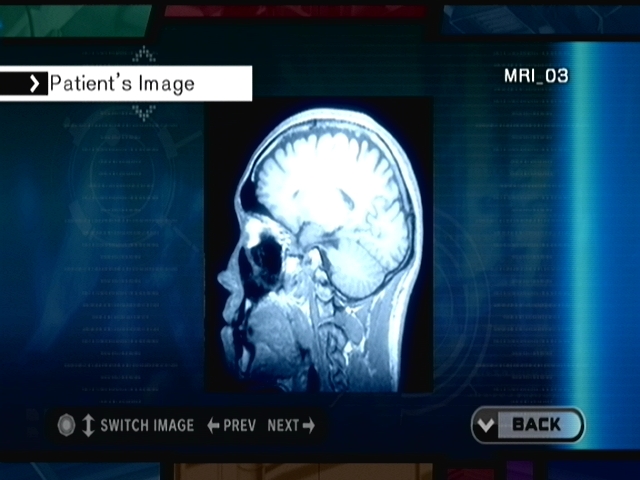
Sample:
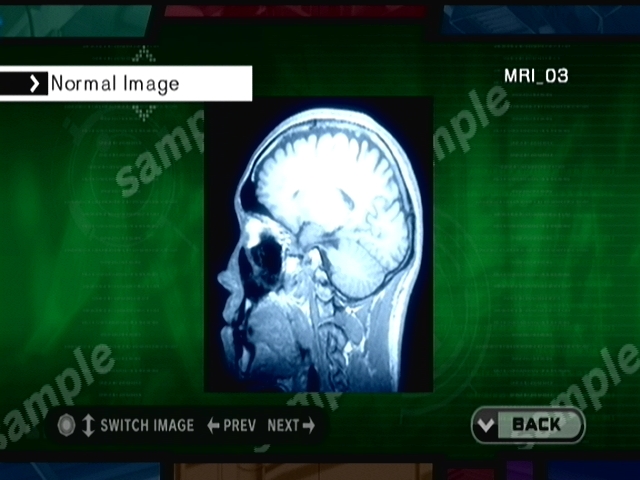
MRI_04
Patient:

Sample:

MRI_05
Patient:
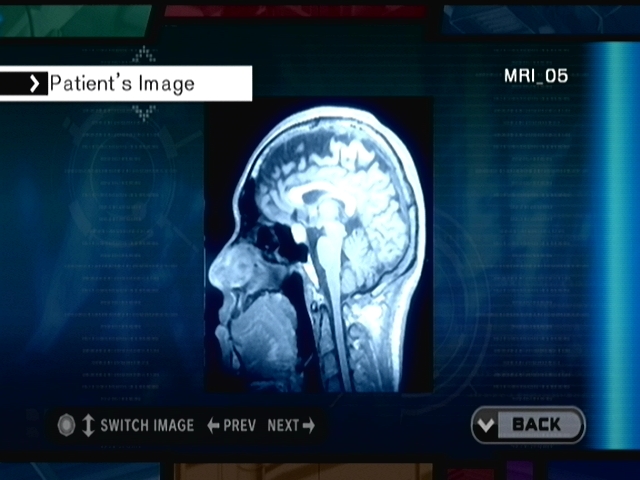
Sample:

First, the medal. This one warrents the full image due to Gabe's smugface.
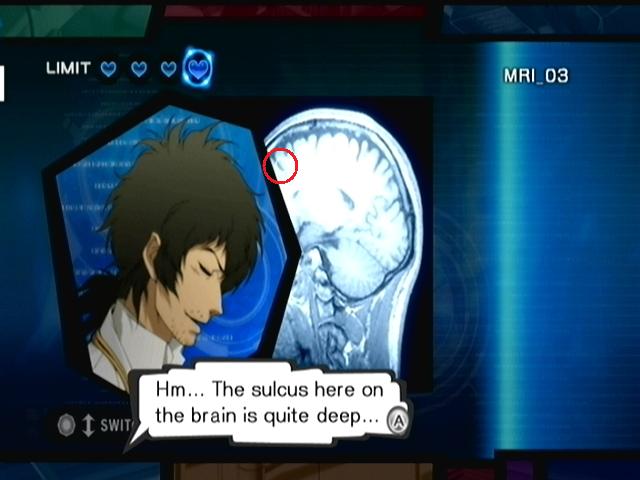
Gabe: This proves he's a pretty smart kid! He inherited that from me, no doubt.
RONI: We should focus on the diagnosis, doctor. And for the record, no definitive link between sulci depth and intelligence has ever been proven.
Gabe: Go ahead and drag your muddy feet all over my dreams.
A sulcus is generally a depression in an organ, but in particular the brain is full of them. Spotting this thing is not exactly easy. Now, the actual problem we're here to diagnose occurs in the last image. The pituitary gland is enlarged.

Gabe: Huh? It's gotten so large... There's no question. This is a pituitary gland tumor.
RONI: New symptom: "Tumor Shadow on Pituitary Gland" Doctor, I recommend that you begin sorting through the symptoms that have been discovered.
Gabe: Yeah, you're right. I should head back to my office.

Symptom List:
Tumor Shadow on Pituitary Gland
Headache
Visual Field Loss
Parathyroid Adenoma
Subperiosteal Bone Resorption
High Intact-PTH
High Serum Gastrin
High Serum PRL
Low Serum Phosphorus
High Blood Calcium
Polydipsia and Poluria
That is a LOT of symptoms, although many tie into the parathyroid gland we already covered. Let's just see what RONI has come up with.
Optic Neuritis:
A condition causing visual disorders due to inflammation of the optic nerve at the rear of the eye.[snip]
We didn't see anything like that.
Open-Angle Glaucoma:
A condition in which ocular tension severely increases, causing damage to the optic nerve.[snip]
No, we need something dealing with the brain.
Meningioma:
A condition in which a tumor has formed on the meninges covering the brain, causing pressure on the brain itself. Symptoms include attacks of epilepsy[snip]
God dammit RONI you're useless.
Pituitary Adenoma:
A condition that causes headaches and vision loss due to increased secretion of prolactin from the adenohypophysis. A blood analysis will detect a high serum PRL level, and an MRI exam will confirm tumor shadows on the pituitary gland.
Finally. This one we can confirm.
Gabe: First the parathyroid gland, and now the pituitary gland? What in the world?
RONI: Doctor, I have located one case in the archives which matches this scenario.
Gabe: I didn't tell you to do that. How did you-
RONI: I applied the "To hell with that!" algorithm recently entered into my registry and made a judgement call.
Gabe: Hahaha, the apple doesn't fall too far from the tree, huh? Even the robo-apple. Now THIS is the kind of partner a doctor should have at his side!
RONI: Yes, doctor. I have indeed been designated as your partner. But the news is not good. This is a disease where the probability of onset is 1 in 10,000.
Gabe: Where is it? Show me the data immediately!
Wermer's Syndrome:
A condition in which tumors form on multiple glands in the endocrine system, such as the pituitary gland, parathyroid gland, and parotid gland. Symptoms include headaches, vision loss, polydipsia and poluria. Analysis will reveal abnormalities such as high serum PRL level, high blood calcium level, low serum phosphorus level, high intact-PTH level, and high serum gastrin level. An X-Ray will reveal subperiosteal bone resorption in the fingers. Tumors in the pituitary gland can be confirmed with an MRI exam. A scintigraphy will confirm an abnormal accumulation into the parathyroid adenoma. While there should be tumor shadows in the pacreas in a CT exam, they will be very small and difficult to discern with an image analysis.
Gabe: Wermer's Syndrome? That's impossible!
RONI: I must disagree, doctor. The probability of this match is roughly 73%.
Gabe: Ungh... To confirm this, we need to check for pancreatic tumors. Order a CT scan.
RONI: Should I also request that this patient be transferred to another doctor?
Gabe: Don't make me repeat myself. I don't pick and choose my patients. I find the symptoms, and diagnose the disease. That's all there is to it.
This is the final challenge. Five more images of the abdomen, and we need to find the tumor shadows. This is actually easier than the brain thing was, though.
CT_01
Patient:

Sample:
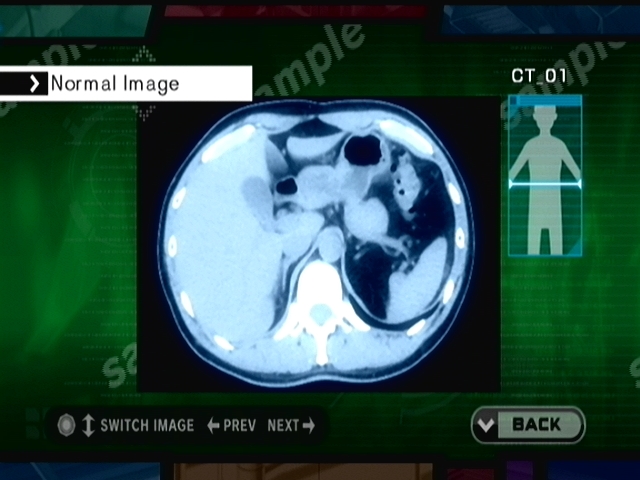
CT_02
Patient:
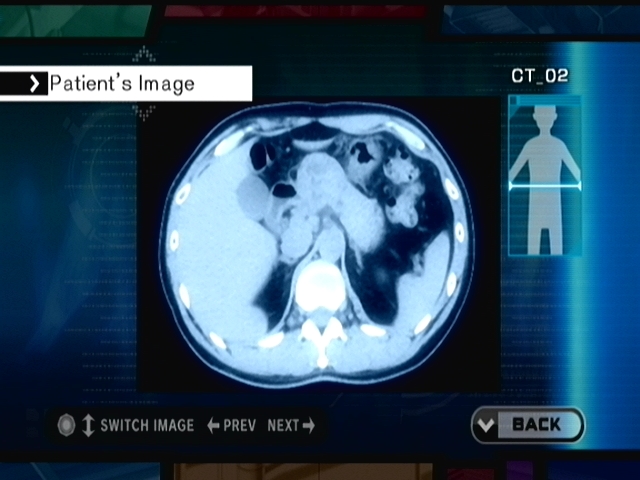
Sample:

CT_03
Patient:

Sample:

CT_04
Patient:

Sample:

CT_05
Patient:

Sample:
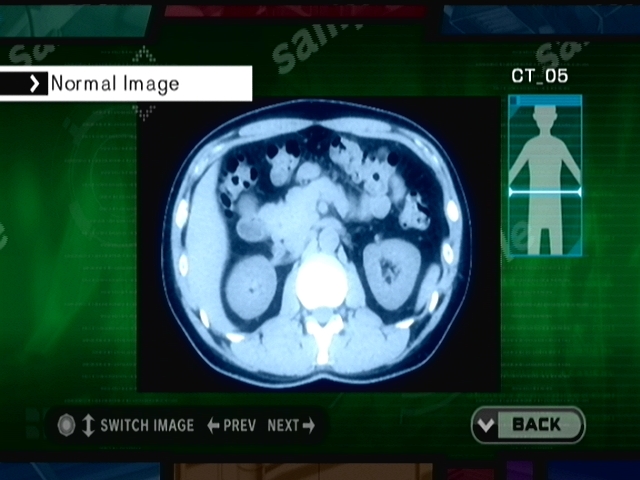
The shadows are in image 4. The pancreas is still swollen, but don't let that distract you.

Gabe: I guess that's that. These shadows look like pancreatic tumors, all right. RONI, I need to make sure. Collate it with the case data.
RONI: Nine matches with previous cases confirmed. These are pancreatic tumors.
Gabe: I see... haha... I think, for once, I'm not so excited about your accuracy.
The Simplest Truth: Ending


Next time: Gotta save Joshua!